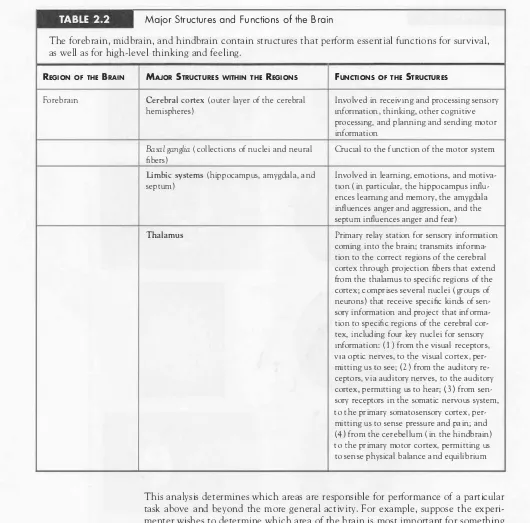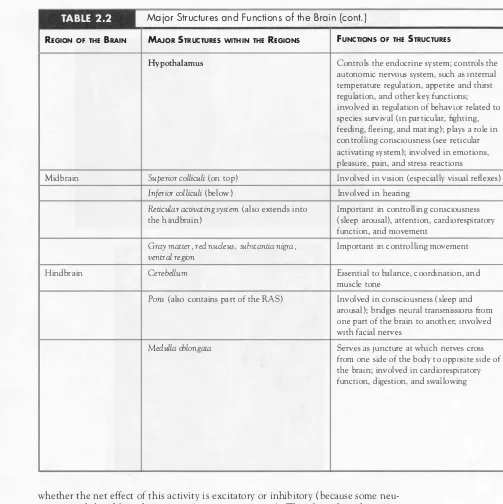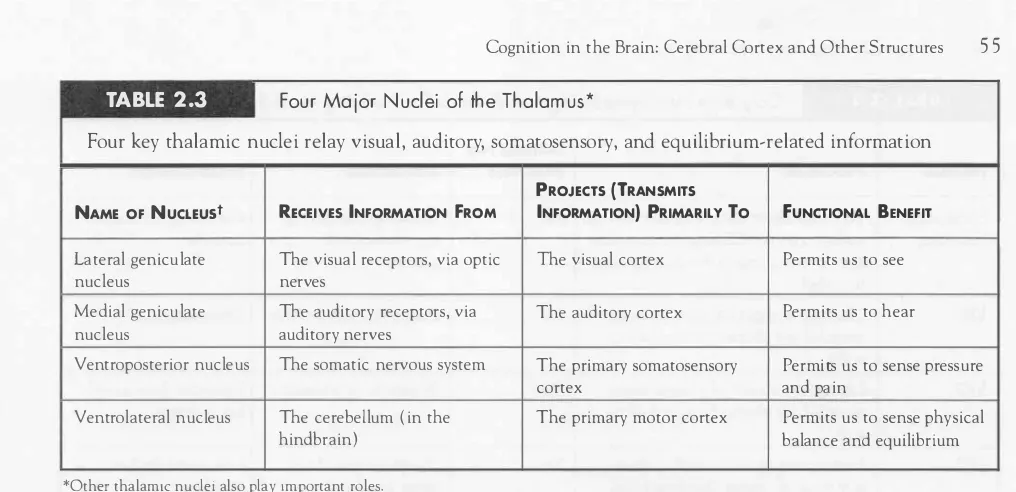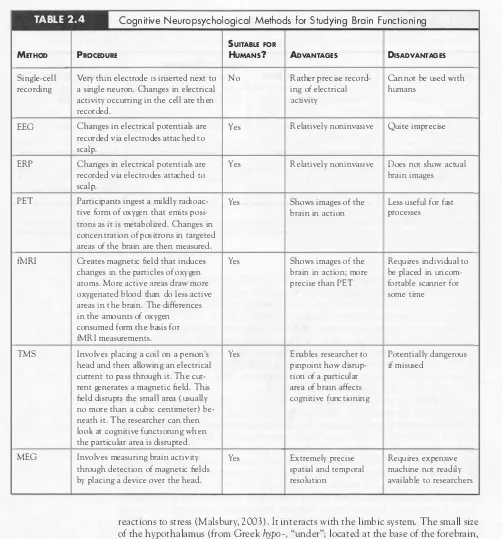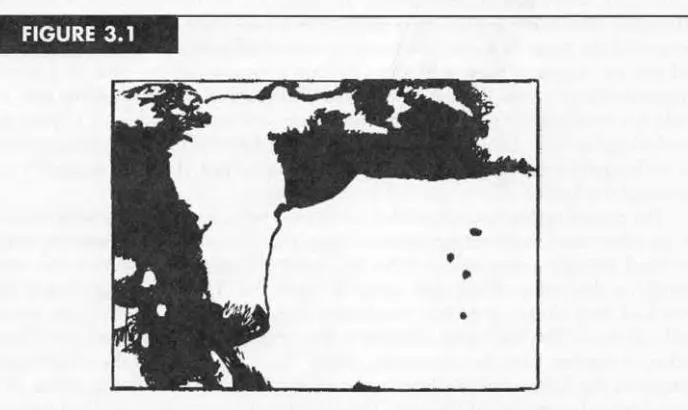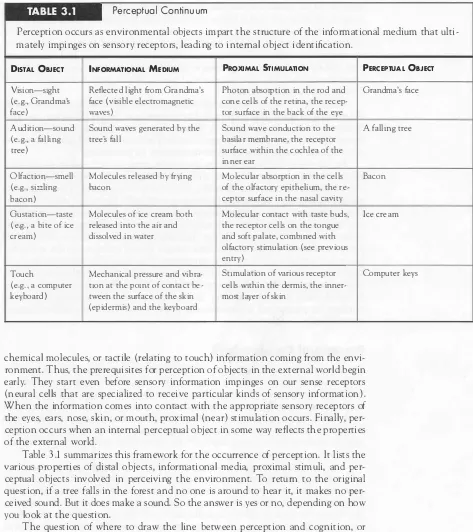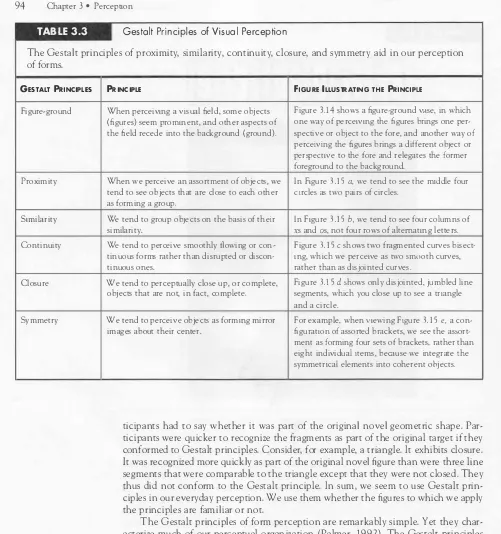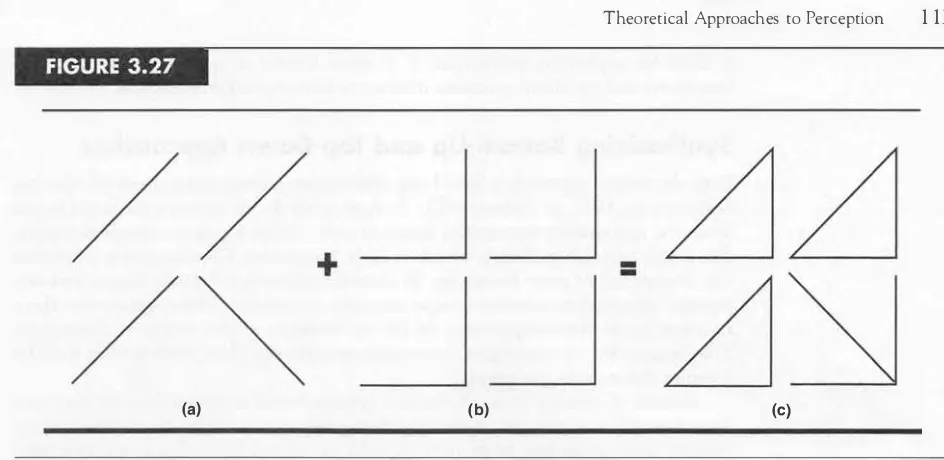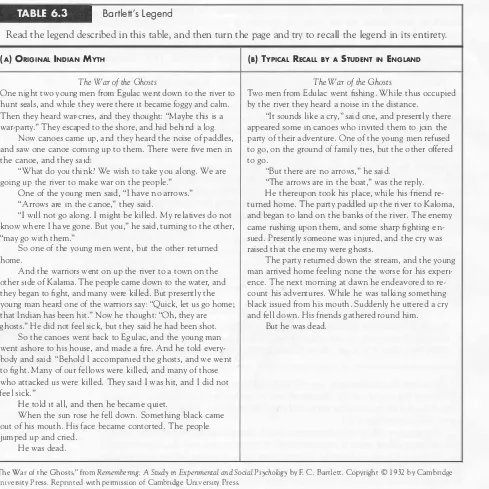Cognitive Psychology
Robert J. Sternberg
Tufts University
with contributions of the
Investigating Cognitive Psychology
boxes by
JeffMio
California State University-Pomona
�..
WADSWORTH
I (ENGAGE
Learning"
Australia· Brazil· Japan· Korea· Mexico· Singapore. Spain' United Kingdom. United States
;...
WADSWORTH
,- (ENGAGE
Learning-Cognitive Psychology, Fifth Edition Robert j. Sternberg
Psychology Editor: jaime A. Perkins
Associate Development Editor: Sr. Marketing Communications Manager:
Linda Yip
Sr. Content Project Manager: Pat Waldo
Creative Director: Rob Hugel
Sr. Art Director: Vernon Boes
Sr. Rights Acquisitions Accounts Manager, Image: Deanna Ettinger
Photo Researcher: Terri Miller
Copy Editor: Graphic World Publishing Services
Cover Designer: Hiroko K. Chastain, Cuttriss
& Hambleton
Cover Images: puzzle piece, key in lock, and person checking watch, Corbis Images; all others, Getty Images
Compositor: Graphic World Inc.
Printed in the United States of America
2
3 4
5 6 7 12
I I10 09 08
© 2009, 2006 Wadsworth, Cengage Learning
ALL RIGHTS RESERVED. No part of this work covered by the copyright herein may be reproduced, transmitted, stored, or used in any form
or by any means graphic, electronic, or mechanical, including but not limited to photocopying, recording, scanning, digitizing, taping, Web distribution, information networks, or information storage and retrieval systems, except as permitted under Section 107 or 108 of the 1976 United States Copyright Act, without the prior written permission of the publisher.
For product information and technology assistance, contact us at
Cengage Learning Customer & Sales Support, 1-800-354-9706 For permission to use material from this text or product,
submit all requests online at cengage.com/permissions
Further permissions questions can be e·mailed to permissionrequest@cengage.com
Library of Congress Control Number: 2007941973 ISBN-13: 978-0-495-50629-4
Cengage Learning is a leading provider of customized learning solutions with office locations around the globe, including Singapore, the United Kingdom, Australia, Mexico, Brazil, and japan. Locate your local office at international.cengage.com/region.
Cengage Learning products are represented in Canada by Nelson Education, Ltd.
For your course and learning solutions, visit academic.cengage.com
Purchase any of our products at your local college store or at our preferred online store www.ichapters.com
,
Contents in Brief
C H A P T E R
1
C H A P T E R
2
C H A P T E R
3
C H A P T E R
C H A P T E R
C H A P T E R
C H A P T E R
C H A P T E R
C H A P T E R
C H A P T E R
10
C H A P T E R
11
C H A P T E R
12
C H A P T E R
13
Glossary
577
References
585
Name Index
641
Subject Index
652
Introduction to Cognitive Psychology
1
Cognitive Neuroscience
33
Perception
74
Attention and Consciousness
123
Memory: Models and Research Methods
176
Memory Processes
216
Representation and Manipulation of Knowledge
in Memory: Images and Propositions
254
Representation and Organization of Knowledge
in Memory: Concepts, Categories, Networks,
and Schemas
302
Language: Nature and Acquisition
341
Language in Context
380
Problem Solving and Creativity
428
Decision Making and Reasoning
479
Human and Artificial Intelligence
528
Contents
iv
CHA PTER
1
Introduction to Cognitive Psychology
1
Exploring Cognitive Psychology
2
Cognitive Psychology Defined
2
Philosophical Antecedents of Psychology: Rationalism versus Empiricism
4
Psychological Antecedents of Cognitive Psychology
5
Early Dialectics in the Psychology of Cognition 5Practical Applications of Cognitive Psychology
7
From Associationism to Behaviorism 8Gestalt Psychology 10
Emergence of Cognitive Psychology
10
Early Role of Psychobiology 10
Add a Dash of Technology: Engineering, Computation, and Applied Cognitive Psychology I I
Research Methods in Cognitive Psychology
12
Goals of Research 12In the Lab of Gordon Bower
14
Distinctive Research Methods 15Investigating Cognitive Psychology
22
Key Issues and Fields within Cognitive Psychology
24
Underlying Themes in the Study of CognitivePsychology 24
Key Ideas in Cognitive Psychology
26
Chapter Previews 29Summary
30
Thinking about Thinking: Factual, Analytical, Creative, and Practical Questions
31
Key Terms
32
Annotated Suggested Readings
32
CHA PTER
2
Cognitive Neuroscience
33
Exploring Cognitive Psychology
34
From Neuron to Brain: Organization of the Nervous
System
34
Neuronal Structure and Function 35
Viewing the Structures and Functions of the Brain 39 Postmortem Studies 40
Animal Studies 40 Electrical Recordings 41
Static Imaging Techniques 42 Metabolic Imaging 42
Cognition in the Brain: Cerebral Cortex and Other Structures
50
Gross Anatomy of the Brain: Forebrain, Midbrain, Hindbrain 51
In the Lab of John Gabrieli
54
Cerebral Cortex and Localization of Function 58 Brain Disorders 67
Key Themes
71
Summary
71
Thinking about Thinking: Factual, Analytical, Creative, and Practical Questions
72
Key Terms
73
COOLAB
73
Annotated Suggested Readings
73
CHA PTER
3
Perception
74
Exploring Cognitive Psychology
75
From Sensation to Representation
79
Basics of Vision 79Some Basic Concepts of Perception 80 Perceptual Constancies 82
Depth Perception 86
Approaches to Object and Form Perception 90
Practical Applications of Cognitive Psychology
90
In the Lab of Stephen Palmer96
Theoretical Approaches to Perception
100
Direct Perception 100Bottom-Up and Top-Down Theories 102
Synthesizing Bottom-Up and Top-Down Approaches 114
vi Contents
Deficits in Perception
115
Agnosias and Ataxias 115Anomalies in Color Perception 118 Akinetopsia and Achromatopsia 119 Key Themes
119
Summary
120
Thinking about Thinking: Factual, Analytical, Creative, and Practical Questions
121
Key Terms
122
COG LAB
122
Annotated Suggested Readings
122
CHAPTER
4
Attention and Consciousness
Exploring Cognitive Psychology124
The Nature of Attention and Consciousness
124
Preconscious Processing 125Investigating Cognitive Psychology
129
Controlled versus Automatic Processes 129In the Lab of John F. Kihlstrom
130
Habituation and Adaptation 137Practical Applications of Cognitive Psychology
137
Attention140
Signal Detection 140
The Nature of Signal Detection 140 Vigilance 142
Search 145
Selective and Divided Attention
152
Basic Paradigms for Studying Selective Attention 152 Filter and Bottleneck Theories of Selective Attention 153 Attentional-Resource Theories of Selective Attention 157 Additional Considerations in Selective Attention 159 Divided Attention 160
Consciousness of Complex Mental Processes 165 A ttention Deficit Hyperactivity Disorder 166 Cognitive Neuroscientific Approaches to Attention
and Consciousness
168
Spatial Neglect 168 A ttentional Systems 169Using Event-Related Potentials to Measure Attention 170 A Psychopharmacological Approach 171
Key Themes
171
Summary
173
•
Thinking about Thinking: Factual, Analytical, Creative, and Practical Questions
174
Key Terms
175
COGLAB
175
Annotated Suggested Readings
175
CHAPTER
5
Memory: Models and Research
Methods
176
Exploring Cognitive Psychology
177
Investigating Cognitive Psychology177
Tasks Used for Measuring Memory177
Recall versus Recognition Tasks 178
Implicit versus Explicit Memory Tasks 180 Traditional Model of Memory
182
Sensory Store 182
Short-Term Store 186
Long-Term Store 188
The Levels-of-Processing Model
189
Practical Applications of Cognitive Psychology
191
An Integrative Model: Working Memory191
Multiple Memory Systems
197
In the Lab of M. K. Johnson198
A Connectionist Perspective200
Memory in the Real World201
Exceptional Memory and Neuropsychology
202
Outstanding Memory: Mnemonists 202Deficient Memory 204
Role of the Hippocampus and Other Structures 210 Key Themes
212
Summary
213
Thinking about Thinking: Factual, Analytical, Creative, and Practical Questions
214
Key Terms
214
COGLAB
215
Annotated Suggested Reading
215
viii Contents
C HA PTER
6
Memory Processes
216
Exploring Cognitive Psychology
217
Encoding and Transfer of Information218
Forms of Encoding 218Transfer of Information from Short- Term Memory to Long-Term Memory 220
Practical Applications of Cognitive Psychology
223
Retrieval228
Retrieval from Short-Term Memory 228 Investigating Cognitive Psychology
228
Retrieval from Long-Term Memory 230Processes of Forgetting and Memory Distortion
231
Interference versus Decay Theory 231Investigating Cognitive Psychology
233
The Constructive Nature of Memory236
Autobiographical Memory 237Memory Distortions 237
In the Lab of Elizabeth Loftus
240
Context Effects on Encoding and Retrieval 244 Memory Development247
Metacognitive Skills and Memory Development 247 Key Themes
250
Summary
251
Thinking about Thinking: Factual, Analytical, Creative, and Practical Questions
252
Key Terms
253
COGLAB
253
Annotated Suggested Readings
253
C HA PTER
7
Representation and Manipulation
of Knowledge in Memory: Images
and Propositions
254
Exploring Cognitive Psychology
255
Mental Representation of Knowledge255
External Representations: Pictures versus Words 257 Investigating Cognitive Psychology
258
Mental Imagery 259
Dual-Code Theory: Analogical Images
Investigating Cognitive Psychology
26 1
Investigating Cognitive Psychology261
In the Lab of Stephen Kosslyn262
Propositional Theory 263Mental Manipulations of Images
270
Mental Rotations 270Investigating Cognitive Psychology
273
Image Scaling 276Investigating Cognitive Psychology
276
Image Scanning 277Investigating Cognitive Psychology
278
Synthesizing Images and Propositions280
Epiphenomena and Demand Characteristics 280 Johnson-Lairds Mental Models 282Neuropsychological Evidence jor Multiple Codes 285 Visual versus Spatial Images 286
Spatial Cognition and Cognitive Maps
289
Rats, Bees, Pigeons, and Humans 289Practical Applications of Cognitive Psychology
289
Mental Shortcuts 29 IText Maps 295
Development oj Visuospatial Skills 296 Key Themes
298
Summary
299
Thinking about Thinking: Factual, Analytical, Creative, and Practical Questions
300
Key Terms
301
COGLAB
30 1
Annotated Suggested Readings
301
CHAPTER
8
Representation and Organization
of Knowledge in Memory: Concepts,
Categories, Networks, and Schemas
302
Exploring Cognitive Psychology
303
Investigating Cognitive Psychology303
Organization of Declarative Knowledge304
Concepts and Categories 305Semantic Network Models 313
Schematic Representations 3 17
Investigating Cognitive Psychology
3 19
Practical Applications of Cognitive Psychology
321
x
ContentsRepresentations of Procedural Knowledge
321
Integrative Models for Representing Declarativeand Nondeclarative Knowledge
323
Combining Representations: ACT-R 323 Models Based on the Human Brain 326Investigating Cognitive Psychology
328
Parallel Processing: The Connectionist Model 329 How Domain General or Domain SpecificIs Cognition? 334
In the Lab of James L. McClelland
335
Key Themes337
Summary
338
Thinking about Thinking: Factual, Analytical, Creative, and Practical Questions
339
Key Terms
340
COOLAB
340
Annotated Suggested Readings
340
CHAPTER
9
Language: Nature and Acquisition
Exploring Cognitive Psychology342
Properties of Language
343
General Description 343Fundamental Aspects of Language 346 Investigating Cognitive Psychology
349
Processes of Language Comprehension350
Speech Perception 350 Semantics and Syntax 355
Investigating Cognitive Psychology
357
In the Lab of Steven Pinker358
Investigating Cognitive Psychology
359
Practical Applications of Cognitive Psychology
364
Language Acquisition364
Stages of Language Acquisition 365 Nature and Nurture 368
Beyond the First Years 373 4nimal Language 374 Key Themes
376
Summary377
Thinking about Thinking: Factual, Analytical, Creative, and Practical Questions
378
Key Terms
379
COOLAB
3 79
Annotated Suggested Readings
379
CHAPTER
10
Language in Context
380
Exploring Cognitive Psychology
381
Reading: Bottom-Up and Top-Down Processes
381
Perceptual Issues in Reading 383Lexical Processes in Reading 383 Language and Thought
387
Differences among Languages 387 Bilingualism and Dialects 394 Slips of the Tongue 399 Metaphorical Language 401 Language in a Social Context403
Investigating Cognitive Psychology
403
Speech Acts 404
Conversational Postulates 407 Gender and Language 409
Practical Applications of Cognitive Psychology
4 10
Discourse and Reading Comprehension 410
Investigating Cognitive Psychology
4 1 1
Investigating Cognitive Psychology4 1 1
Investigating Cognitive Psychology
4 12
In the Lab of Richard Gerrig4 14
Neuropsychology of Language417
Aphasia 417Autism 419
Lesion Studies and Event-Related Potentials Research 420 Other Methods 423
Key Themes
424
Summary
425
Thinking about Thinking: Factual, Analytical, Creative, and Practical Questions
426
Key Terms
427
COG LAB
427
Annotated Suggested Reading
427
CHAPTER
1 1
Problem Solving and Creativity
Exploring Cognitive Psychology
429
The Problem-Solving Cycle430
Types of Problems434
Well-Structured Problems 434
Investigating Cognitive Psychology
435
Ill-Structured Problems and the Role of Insight 441428
xii
Contents
Obstacles and Aids to Problem Solving
449
Mental Sets, Entrenchment, and Fixation 449 Negative and Positive Transfer 451
In the Lab of K. Anders Ericsson
452
Investigating Cognitive Psychology453
Investigating Cognitive Psychology453
Practical Applications of Cognitive Psychology
455
Incubation 457Expertise: Knowledge and Problem Solving
459
Organization of Knowledge 459Innate Talent and Acquired Skill 466 Creativity
468
It's How Much You Produce 468 It's W hat You Know 469 It's Who You Are
It's Where You Are All of the Above
471 472 472
Types of Creative Contributions
474
Investigating Cognitive Psychology
475
Key Themes
475
Summary476
Thinking about Thinking: Factual, Analytical, Creative, and Practical Questions
477
Key Terms
477
COGLAB
478
Annotated Suggested Readings
478
CHA PTER
12
Decision Making and Reasoning
Exploring Cognitive Psychology480
Investigating Cognitive Psychology Judgment and Decision Making
481
Classical Decision Theory 481 Satisficing 483Elimination by Aspects 484 Naturalistic Decision Making
Group Decision Making 486
Heuristics and Biases 488
485
Investigating Cognitive Psychology Investigating Cognitive Psychology Investigating Cognitive Psychology
Neuroscience of Decision Making 497 In the Lab of Gerd Gigerenzer
498
480
488
494
494
Deductive Reasoning
499
Conditional Reasoning 499 Syllogistic Reasoning 505Linear Syllogisms 505
Investigating Cognitive Psychology
505
Further Aids and Obstacles to Deductive Reasoning 512 Practical Applications of Cognitive Psychology
513
Inductive Reasoning513
Reaching Causal Inferences 515 Categorical Inftrences 519 Reasoning by Analogy 519
Development of Inductive Reasoning 520 An Alternative View of Reasoning
521
Investigating Cognitive Psychology
523
Neuroscience of Reasoning 523Key Themes
524
Summary525
Thinking about Thinking: Factual, Analytical, Creative, and Practical Questions
526
Key Terms
527
COGLAB
527
Annotated Suggested Readings
527
CHA PTER
13
Human and Artificial Intelligence
Exploring Cognitive PsychologyInvestigating Cognitive Psychology
529
529
Measures and Structures of Intelligence531
Spearman: The "g" Factor 536Thurstone: Primary Mental Abilities 538 Guilford: The Structure of Intellect 538
Cattell, Vernon, and Carroll: Hierarchical Models 539 Information Processing and Intelligence
539
Process-Timing Theories 539Working Memory 542
Componential Theory and Complex Problem Solving 542 In the Lab of Randall Engle
544
Biological Bases of Intelligence 546
Alternative Approaches to Intelligence
548
Cultural Context and Intelligence 548 Gardner: Multiple Intelligences 553 Sternberg: The Triarchic Theory 555Practical Applications of Cognitive Psychology
558
528
xiv
Contents
Improving Intelligence: Effective, Ineffective, and Questionable Strategies
558
Investigating Cognitive Psychology
559
Development of Intelligence in Adults561
Artificial Intelligence: Computer Simulations564
Can a Computer Program Be "Intelligent"? 564 Questions about the Intelligence of IntelligentPrograms 571
Key Themes
573
Practical Applications of Cognitive Psychology
574
Summary574
Thinking about Thinking: Factual, Analytical, Creative, and Practical Questions
576
Key Terms
576
Annotated Suggested Readings
576
Glossary References Name Index Subject Index
577
585
To the Instructor
Every year it was a gamble , and e very year I lost: I had taught cognitive psychology a
number of times during my years of teac hing at Yale, and I had never used the same
textbook twice. For whatever reason, my students were never taken with any of the
books and neither was
1.
T he book was too hard or too easy, too narrow or too broad,
too dated or too trendy. They were decent books, just not the right books. Finally, I
decided to stack t he deck and write t he book myself. In t his preface , I describe my
goals for both t he fifth edition and for t he original text in particular.
What's
New
in
Cognitive Psychology,
Fifth Edition
In Cognitive Psychology, fifth edition, you will find many c hanges. T he biggest c hange
reflects the explosion of knowledge in t he field. T here are more than 5 00 new refer
ences , greatly updating the coverage provided by the book. A second c hange , by
popular demand, is t hat material on neurons and neurotransmitters t hat had been
eliminated in t he fourth edition is back and updated in t he fifth edition. A t hird major
c hange , also by popular demand, is t hat the order of C hapters
3
and 4
has been re
versed, with attention now following perception. A fourth major change is t hat consid
erable cogniti ve-neuroscience material has been added to c hapters throughout t he
book, including whole sections t hat have not appeared before. A fifth c hange is t hat
additional practical examples rele vant to students' e veryday lives have been added to
t he book. A sixth general c hange is t hat "In t he Lab " boxes have been updated, with
many of the boxes being entirely new. And a seventh general c hange is that e very
sentence has been reviewed to ensure its complete readability.
T here are also many specific c hanges:
Chapter
1
1. T he usefulness of cogniti ve psyc hology is s hown right from t he start with
t he example of the availability heuristic applied to t he 2008 presidential
election.
2. T he point is made that either/or thinking can be detrimental to science.
For example , intelligence is not either heritable or environmental , but
rather both.
3.
A discussion of t he importance of applied cogniti ve psychology is
stressed in t his c hapter, giving aviation as an example.
xvi To the Instructor
4.
I have added a disc ussion of t he modularity of mind concept.
5.
T he disc ussion of statistical inference has been upgraded and clarified.
6. The discussion of experimental design and correlation has also been up
graded and clarified.
7. The s ubtraction metho d, now used in many studies in cognitive neurosci
ence, is explained.
8. Disc ussions of Genie and P hineas Gage have been added to explore the
e ffects of trauma.
9.
More material on the validity of self-reports has been added.
10. T he disc ussion of artificial intelligence has been enhanced.
Chapter 2
1. T he material on neurons and neural transmitters and their functioning,
taken o ut of the last edition, is back by pop ular demand.
2. T here is an enhanced and updated disc ussion of e vent-related potentials
(ERP) methods.
3.
There is now an improved disc ussion of functional magnetic resonance
imaging ( fMRI) .
4.
Material on positron emission tomography (PET) has been enhanced.
5.
P harmacological magnetic resonance imaging ( phMRI) is now discussed.
6. Diffusion tensor imaging (DT!) is now discussed.
7. Magnetoencep halography (MEG) is now discussed.
8. More material on t he amygdala has been added.
9.
T here is a disc ussion of autism and its brain bases.
10. Material on the hypothalamus has been enhanced.
11. Material on t he lobes of the brain has been added.
12. Material on Brodmann areas has been added.
Chapter 3
1. T here is now a disc ussion of t he ways in w hic h humans are s uperior to
robots.
2. S ubstantial material has been added on vision.
3.
Material on depth perception has been added.
4.
Landmark-centered representation is now discussed.
5.
Material on t he structuralist approach was deleted at reviewers' request.
6. The neural bases offace recognition are disc ussed. In general, s ubstantial
information on face recognition has been added.
7. T here is a new disc ussion on perception in a utism.
8. The expert-indi viduation hypothesis is now presented.
9.
The material contrasting bottom-up and top -down processing has been
modified substantially and pared down at reviewers' request.
10. The lengthy dis cussion of Hubel and Wiesel's early findings has been
pared down greatly be cause they are now out of date, and the discussion
has been updated with recent findings.
11. Ataxias are now dis cussed.
12. Agnosias are mentioned.
13. Different forms of pro sop agnosia are dis cussed.
14. The dis cussion of anomalies in color perception has been upgraded and
updated.
15 . Achromatopsia is now dis cussed.
Chapter
4
1. A discussion of visual priming has been added.
2. Material on the tip -of-the-tongue phenomenon has been added.
3. The potential e ffe ct of a stroke on the visual cortex is dis cussed.
4. Material on dyslexia has been added.
5. Tinnitus is now dis cussed in relation to auditory habituation.
6.
Coverage of signal-detection theory (SDT) has been broadened to note
that it can be applied in a variety of cognitive contexts.
7. The brain bases of vigilance are now dis cussed.
8. The dis cussion of movement-filter theory was deleted at re viewers'
request.
9.
Cherry'S co cktail party phenomenon is related to working memory.
10. There is an enhanced dis cussion of the Stroop effect.
II.
Talking on cell phones is dis cussed in terms of attentional theory.
12. Cultural di fferences in attentional processes are dis cussed.
13. Neural bases of attention deficit hyperactivity disorder (ADHD) are dis
cussed in some detail.
Chapter
5
1. There is a new discussion of savings.
2. There is new material on the effe cts of informing students in advance of
how their memory will be tested.
3.
Impli cit memory and expli cit memory are compared across the life
span.
4. There is new material on the role of the cerebellum in procedural
memory.
x viii
To the Instructor
5. T here is new material on American Sign Language (AS L).
6. More practical material has been added, suc h as remembering street
names from your c hildhood.
7. T here is expanded discussion of the self-reference e ffect.
8.
T here is new material on subvocal rehearsal.
9.
T here is an added discussion of the episodic buffer.
10. There is further material on resource allocation in working-memory
tasks.
11. There is further discussion of whether episodic memory and semantic
memory comprise distinct stores of information.
12. T here is further discussion of the role of relating new information to old
information to facilitate learning of material.
13. There is inclusion of updated material on H. M.
14. T here is further information on amnesia and its relation to procedural
knowledge.
Chapter
6
1. Additional information is included on the relationship between stress and
memory.
2. New material has been added on sleep and memory.
3. There is further discussion of t he role of t he hippocampus in attempts at
learning during sleep.
4. T here is a new discussion of reconsolidation.
5. There is new discussion of the relation between age and prospecti ve
memory.
6.
There is an added discussion of probability models for separating storage
from retrieval.
7. Proactive interference in alcoholic and nonalcoholic individuals is dis
cussed, particularly in relation to Brodmann area 45.
8.
T here is a new discussion of t he relation of self-esteem to autobiograph
ical memory.
9.
T here is new material on the role of stress in eyewitness identification.
10. There is new material on memory development.
11. T here is new material on how suggestion can influence memory.
12. T here is new material on t he Roediger-McDermott-Deese paradigm.
13. Spreading acti vation is now explained more clearly.
14. There is new material on flashbulb memory and emotional invol vement ,
as well as on t he potential for distortion of flashbulb memories.
15. Re hearsal is discussed in relation to ADHD.
Chapter
7
I.
There is a new discussion of mental imagery among c hildren with Down
syndrome.
2. T here is further discussion of how analogue and propositional representa
tions can coexist.
3. There is new material on how viewing an image or imagining it activates
t he same brain areas.
4. There is a new discussion of mental imagery in patients with schizophrenia.
5. The role of t he motor cortex in mental rotation is discussed.
6.
There is new material on sex differences in spatial imagery and t he brain
bases of t he di fferences.
7. There is new material on how training can decrease sex differences in
spatial visualization tasks.
8. There is an entirely new section on representational neglect.
9.
There is new material on haptic imagery and its relation to visual imagery.
10. There is new material on mental models.
11. There is new material on neuropsyc hological bases of mental maps.
Chapter
8
1. There is new information on speed of assigning information to natural
versus artifact categories.
2. There is further discussion of exemplar t heories of categorization.
3. T here is new information on semantic networks.
4. There is new information on cogniti ve impairments (e.g. , semantic de
mentia) and how t hey affect categorization.
5. There is new information on cogniti ve impairment (e.g. , schizop hrenia)
and scripts.
6.
T here is furt her information on spreading acti vation in mental repre
sentation.
7. Practical examples of proceduralization, suc h as air traffic control and
learning p hone numbers , are discussed.
8. Dyslexia is discussed in the context of parallel distributed processing
(PDP) models.
9.
Use of fMRl methods to study face recognition is discussed.
Chapter
9
1. A discussion of how language e vol ves over time has been added.
2. T here is a new discussion of language extinction.
xx
To the Instructor
3. There is a new presentation of material on coarticulation.
4. There is a discussion of the use of phonological information by people
with and without reading disabilities.
5. T here is further discussion of the McGurk effect.
6.
T here is new discussion of denotation and connotation.
7. There is further discussion of syntactical priming.
8.
There is new material on infants and how they respond to emotional in
formation contained in communication.
9.
T here is a new presentation of material on cooing in c hildren with
cere-bral palsy.
10. There is new material on babbling and ASL.
I I.
T here is further material on innate language abilities.
12. There is new material on the role of imitation in language learning.
13. There is new information on c hild-directed speec h.
14. New material appears on Koko the gorilla.
Chapter 10
I.
T here is more material on the sentence-superiority effect.
2. There is a discussion, in the context of linguistic relati vity, of how famil
iarity with computers may breed more words for computer-associated
concepts.
3. There is an enhanced discussion of how language c hoice affects other
aspects of information processing.
4. There is now a discussion of how teac hers may discourage bilingualism.
5. T here is an added discussion of bilingualism and age of acquisition of
second language.
6.
T here is a discussion of ap hasia and how it affects bilingualism.
7. There is a discussion of how judgments of dialects can lead to biases in
e valuating people.
8.
There is a new discussion of personal space -both across cultures and in
virtual-reality environments.
9.
There is more material on indirect requests.
10. There is a discussion of language and autism, whic h includes the theory
of executive dysfunction.
I I.
Gender differences in use of written language is discussed.
12. T he relation of vocabul ary size to other cognitive skills is discussed.
13. The role of Broca's area in sign production is discussed.
14. T here is new material on neuropsyc hological analysis of language with
fMRI and ERP.
Chapter 1 1
1. The relation of emotional intelligence to proble m solving is discussed.
2. A be tter explanation is provided of types of errors in the hobbits and orcs
problem.
3. Neuropsychological bases of insight are discussed.
4. The role of sleep in helping to produce insightful solutions is no ted.
5.
New material is presented on the relatively young age at which analogical
thinking can be observed.
6.
The effects of brain injury on problem solving are discussed in some detail.
7. As a real-world example , expe rt-novice differences are discussed in the
context of tasting beers.
8.
I t is noted that expert mathe maticians use visual i magery in problem
solving even for problems that do not require i t.
9.
Further discussion has been added of the effec ts o f verbal protocols on
problem solving.
10. Preparation in problem solving is discussed in the con tex t of A SL
produc tion.
II.
There is new discussion of how knowledge helps creativity.
12. There is further discussion of the role of rewards in creative behavior.
13. A sec tion has been added on the neuroscience of creativi ty.
Chapter 1 2
1. A new sec tion on naturalistic decision making has been added.
2. A new sec tion on group decision making has been added.
3. A new sec tion on groupthink has been added.
4.
A new sec tion on antido tes for groupthink has been added.
5.
An expanded discussion of the inclusion fallacy has been added.
6. A further discussion of fas t and frugal heuristics has been added.
7. A sec tion on the neuroscience o f decision making has been added.
8.
Evidence on the trainabili ty of mental models has been added.
9.
A further discussion of confirmation bias is included.
10. The use of analogy in politics is discussed.
I I.
A sec tion on the neuroscience of reasoning has been added.
Chapter 13
I.
New material on emo tional intelligence has been added.
2. New material on cultural intelligence has been added.
xxii
To the Instructor3. The use of the Wechsle r scale in neuropsychological assessment is
discussed.
4. More mate rial on the relationship of working memo ry to intelligence is
included.
5.
C rystallized intelligence is related to the brain and to brain damage.
6.
More mate rial on the relationship of intelligence to b rain function has
been included.
7. More material on cultu ral differences in thought p rocesses is included.
8.
New empirical material on using b road theories of intelligence to p redict
college success is included.
9.
More material updating findings on the Abecedarian Project is included.
10. New mate rial about the importance of students' beliefs on the malleabil
ity of intelligence is included.
11. New mate rial on intelligent systems is included.
12. New mate rial on mode rn applications of artificial intelligence
ISincluded.
The Original Goals of This Book
When I fi rst unde rtook to write this textbook, I knew what I wanted in a textbook, and
I knew what my students wanted; or at least I thought I did. We wanted a book that
would achieve a number of objectives.
1.
Combine readability with integrity.
I have chosen books that were so
chewy that only the strongest stomachs could digest thei r contents , and I
have chosen ones that melted like cotton candy, with substance to match.
I have tried to w rite a book that would give students something to chew
on , but one that they could easily digest.
2.
Balance a clear presentation of the big questions of cognitive psychology
with a respect for the important details of the field.
Perhaps in no course
more than in cognitive psychology are both the fo rest and the trees im
po rtant. The best and most lasting work in the field is driven by enduring
and fundamental questions. Howeve r, that work also respects the details
of methods and data analysis needed to p roduce meaningful results. In
order to achieve the balance, I have opened each chapte r with a p review
of the big questions dealt with in that chapter and ended each chapte r
with a summary of what we have learned in the field that addresses each
question. Within the chapte rs , the writing has been guided by the big
questions , while conveying to students the kinds of details to which cog
nitive psychologists need to attend in both thei r theo ry and research.
3.
Balance the learning of subject matter with thinking about the subject
matter.
An expert cognitive psychologist knows the discipline but can
also use the knowledge. Knowledge without thought is useless, but
thought without knowledge is empty. I have t ried to balance a respect for
s ubject matter with an e qual respect for its use. Every chapter ends with
dive rse questions that emphasize comp rehension of the s ubject matter, as
well as analytical , creative , and p ractical thinking with that s ubject mat
ter. Students using this book will not only learn the basic ideas and facts
of cognitive psychology, b ut also how to think with the m.
4.
Recognize both the traditional and emerging trends in the field. This book
has all the traditional topics fo und in the chapters of the majority of text
books , including the nature of cognitive psychology and how people
think about issues in cognitive psychology (Chapter 1) , pe rception
(Chapte r 3) , attention and consciousness (Chapter
4),
me mo ry (Chapters
S and
6),
knowledge rep resentation (Chapters 7 and 8) , language (Chap
ters
9
and 10) , p roble m solving and creativity (Chapter 11) , and decision
making and reasoning (Chapter 12).
I have also incl uded two chapte rs that are not typically incl uded as
chapters in other books. The chapte r on cognitive neuroscience (Chapter
2) is incl uded beca use the dividing line between cognitive psychology and
psychobiology is becoming inc reasingly indistinct. A g reat deal of excit
ing wo rk today is at the interface between the two fields , and so , whereas
the cognitive psychologist of 20 years ago might have been able to get
away witho ut an understanding of biological fo undations , I believe that
today s uch a cognitive psychologist would be ill served.
H uman and artificial intelligence (Chapte r 13) are becoming increas
ingly important to the field of cognitive psychology. Twenty years ago , the
field of h uman inteIligence was do minated by psychometric (test-based)
approaches. The field of artificial inteIligence was dominated by p rog rams
that were functionally rather remote fro m h uman thought p rocesses. To
day both fields of intelligence are more heavily influenced by cognitive
models of how people p rocess information. I include both h uman- and
comp ute r-based models in the same chapter because I believe that their
goals are ulti mately the same-namely, to understand h uman cognition.
Although the book ends with the chapter on intelligence, intelligence
also plays a major role in the beginning and the middle of the book be
cause it is the o rganizing framewo rk within which cognitive psychology
is presented. This framework is not in terms of a traditional psychometric
model of intelligence, b ut rather in te rms of intelligence as the fundamen
tal organizing framewo rk fo r all of h uman cognition.
I have tried not only to balance traditional and newer topics, b ut also
older and mo re recent citations. So me books see m to s uggest that almost
nothing new has happened ove r the past decade , whe reas othe rs seem to
s uggest that cognitive psychology was invented in that decade. The goal
of this book is to balance citation and description of classic studies with
e qual attention to recent, exciting contributions to the field.
S.
Show the basic unity of cognitive psychology.
On one hand, cognitive
psychologists disagree about the extent to which the mechanisms of cog
nition are domain specific vers us do main general. On the other hand, I
believe that almost all cognitive psychologists believe that there is a
xxiv
To the Instructor
damental functional uni ty to human cognition. This unity, I believe , is
expressed through the concept of human intelligence.
The concept of intelligence can be seen as p roviding a unifying um
b rella through which to understand the adaptive nature of human cogni
tion. Through this single concept, society, as well as psychological sci
ence , acknowledges that as diverse as cognition may be , i t comes toge the r
i n p roviding us with a functionally unified way o f making sense o f and
adapting to the environment. Thus, the unity of human cognition, as ex
p ressed by the concept o f intelligence , serves as an integ rating message
fo r this book.
6.
Balance various forms of learning and instruction.
Students learn bes t
when they learn material in a variety of ways and from di fferent vantage
points. To this end, I have sought to achieve a balance among a traditional
p resentation o f text, a variety of kinds o f questions about the material
( fac tual , analytical, creative, p rac tical) , demonstrations of key ideas in
cognitive psychology, and anno tated sugges ted readings that students can
consult i f they wish for further information about a topic. A chapte r out
line at the beginning o f each chapte r also se rves as an advance organizer
for what is to come. The opening questions and closing answers help
students appreciate the main questions in the field, as well as what p rog
ress we have made toward answering them. The text i tself e mphasizes
how contemporary ideas have evolved from pas t ones , and how these
ideas address the key questions cogni tive psychologis ts have sought to
answer in their research.
Acknowledgments
I am g rateful to a number o f reviewers who have contributed to the development o f
this book: Susan E. Dutch, Westfield State College; Jere my Go ttlieb , Carthage Col
lege; Andrew Herbert, Rocheste r Insti tute of Technology; Christopher B. Mayho rn,
No rth Carolina State Universi ty; Pad raig G. O'Seaghdha, Lehigh Unive rsi ty; Thad
Polk, University of Michigan; David Somers , Boston Unive rsity.
To the Student
Why do we remember people who m we met years ago , but someti mes seem to forget
what we learned in a course sho rtly after we take the final exam (or worse , someti mes
right before) ? How do we manage to carry on a conversation with one person at a
party and simultaneously eavesdrop on anothe r mo re interesting conversation taking
place nearby? Why are people so often ce rtain that they are co rrect in answe ring a
question when in fac t they are not? These are just three of the many questions that are
addressed by the field of cognitive psychology.
Cogni tive psychologists study how people perceive, learn, remember, and think.
Although cognitive psychology is a unified field, i t draws on many other fields, most
notably neuroscience, computer science, linguistics, anth ropology, and philosophy.
Thus, you will find some of the thinking of all these fields represented in this book.
Moreover, cogni tive psychology interacts with other fields within psychology, such as
psychobiology, developmental psychology, social psychology, and clinical psychology.
Fo r example, i t is difficul t to be a clinical psychologist today without a solid
knowledge of developments in cognitive psychology because so much of the thinking
in the clinical field draws on cognitive ideas, both in diagnosis and in therapy. Cogni
tive psychology has also provided a means fo r psychologists to investigate experi men
tally some of the exciting ideas that have eme rged from clinical theory and p ractice ,
such as notions of unconscious thought.
Cognitive psychology will be i mportant to you not only in i ts own right, but also
in helping you in all of your work. Fo r example, knowledge of cognitive psychology
can help you better unde rstand how best to study for tests, how to read effectively, and
how to remember di fficult-to-learn material. However, to acquire this knowledge , you
need to make use of the following pedagogical features of this book:
1.
Chapter outlines,
beginning each chapter, summarize the main topics
covered and thus give you an advance ove rview of what is to be covered
in that chapter.
2.
Opening questions emphasize the main questions each chapter addresses.
3.
Boldface terms,
indexed at ends of chapte rs and defined in the glossary,
help you ac quire the vocabulary of cognitive psychology.
4.
End-of-chapter summaries
return to the questions at the opening of each
chapter and show our current s tate of knowledge with regard to these
questions.
5.
End-of-chapter questions
help you ensure both that you have learned the
basic mate rial and that you can think in a variety of ways (factual , ana
lytical , c reative , and practical) with this mate rial.
xxvi
To the Student
6.
A nnotated suggested readings
refer you to other sources that you can
consult for further information on the topics covered in each chapter.
7.
"Investigating Cognitive Psychology " demonstrations,
appearing
throughout the chapters, help you see how cognitive psychology can be
used to demonstrate various psychological phenomena.
8.
"Practical Applications of Cognitive Psychology " demonstrations
show
how you and others can apply cognitive psychology to your everyday lives.
9.
"In the Lab of . . . " boxes tell you what it really is like to do resea�ch in
cognitive psychology. Prominent researchers speak in their own words
about their research-what research problems excite them most and what
they are doing to address these problems.
10.
Key Themes sections,
near the end of each chapter, relate the content of
the chapters to the key themes expressed in Chapter 1. These sections will
help you see the continuity of the main ideas of cognitive psychology
across its various subfields.
11.
CogLab,
an exciting series of laboratory demonstrations in cognitive
psychology provided by the publisher of this textbook (Wadsworth), is
available for purchase with this text. You can actively participate ih these
demonstrations and thereby learn firsthand what it is like to be involved
in cognitive-psychological research.
This book contains an overriding theme that unifies all the diverse topics found in
the various chapters: Human cognition has evolved over time as a means of adapting
to our environment, and we can call this ability to adapt to the environment
intelli
gence. Through intelligence, we cope in an integrated and adaptive way with the many
challenges with which the environment presents us.
Although cognitive psychologists disagree about many issues, there is one issue
about which almost all ofthem agree; namely, cognition enables us to successfully adapt
to the environments in which we find ourselves. Thus, we need a construct such as that
of human intelligence,
if only to provide a shorthand way of expressing this fundamental
unity of adaptive skill. We can see this unity at all levels in the study of cognitive psy
chology. For example, diverse measures of the psychophysiological functioning of the
human brain show correlations with scores on a variety oftests of intelligence. Selective
attention, the ability to tune in certain stimuli and tune out others, is also related to intel
ligence, and it has even been proposed that an intelligent person is one who knows what
information to attend to and what information to ignore. Various language and problem
solving skills are also related to intelligence, pretty much without regard to how it is
measured. In brief, then, human intelligence can be seen as an entity that unifies and
provides direction to the workings of the human cognitive system.
About the Author
ROBERT J. STERNBERG
Robert J. Sternberg is Dean of the School
of Arts and Sciences, Professor of Psy
chology, and Adjunct Professor of Educa
tion at Tufts University. He is also Honor
ary Professor of Psychology in the
Department of Psychology at the Univer
sity of Heidelberg, Heidelberg, Germany.
Prior to accepting his positions at Tufts,
he was IBM Professor of Psychology and
Education in the Department of Psychol
ogy, Professor of Management in the
School of Management, and Director of
the Center for the Psychology of Abilities, Competen
cies, and Expertise at Yale. The Center, now relocated
to Tufts, is dedicated to the advancement of theory,
research, practice, and policy advancing the notion of
intelligence as developing expertise-as a construct
that is modifiable and capable, to some extent, of de
velopment throughout the life span. The Center seeks
to have an impact on science, education, and society.
Sternberg was the 2 003 President of the American
Psychological Association (APA) and is the
2006-2007 President of the Eastern Psychological Associa
tion. He is President-Elect of the International Asso
ciation for Cognitive Education and Psychology. He
was on the Board of Directors of the APA (2 002-2 004)
and on the Board of Trustees of the APA Insurance
Trust (2 004) and the American Psychological Founda
tion (2 005-2 007). He is on the Board of Directors of
the Eastern Psychological Association (2 005-2008)
and the American Association of Colleges and Univer
sities (2 007-2 009). He is also Chair of the Publica
tions Committee of the American Educational Re
search Association (AERA). Sternberg has been
President of the Divisions of General Psychology,
Educational Psychology, Psychology and the Arts, and
Theoretical and Philosophical Psychology of the APA.
Sternberg has been Acting Chair and
with honors with exceptional distinc
tion in psychology, from Yale University
in 1972. He also holds honorary doctor
ates from Complutense University of
Madrid, Spain; University of Leuven,
Belgium; University of Cyprus;
Univer-sity of Paris
V,
France; Constantine the
Philosopher University, Slovakia; University of Dur
ham, England; St. Petersburg State University in
Russia; University of Tilburg in Holland; and Ri
cardo Palma University in Peru.
Sternberg is the author of about 12 00 journal ar
ticles, book chapters, and books and has received over
$2 0 million in government and other grants and con
tracts for his research. The central focus of his research
is intelligence, creativity, and wisdom, and he also has
studied love and close relationships, as well as hate.
This research has been conducted on five different
continents.
xxviii
About the Author
Thorndike Award for Career Achievement in Educa
tional Psychology Award from the Society for Educa
tional Psychology of the APA; the Arnheim and
Farnsworth Awards from the Society for the Psychol
ogy of Creativity, Aesthetics, and the Arts of the
APA; the Boyd R. McCandless Award of the Society
for Developmental Psychology of the APA; the Dis
tinguished Award for an Early Career Contribution to
Psychology from the APA; the Positive Psychology
Network Distinguished Scientist and Scholar Award;
the Palmer O. Johnson, Research Review, Outstand
ing Book, and Sylvia Scribner Awards from the
AERA; the James McKeen Cattell Award from the
APS; the Distinguished Lifetime Contribution to
Psychology Award from the Connecticut Psychologi
cal Association; the Anton Jurovsky Award of the
Slovak Psychological Society; the International
Award of the Association of Portuguese Psycholo
gists; the Distinguished Contribution Award and E.
Paul Torrance Award of the National Association for
Gifted Children; the Cattell Award of the Society for
Multivariate Experimental Psychology; the Award for
Excellence from the Mensa Education and Research
Foundation; the Distinction of Honor SEK from the
Instituci6n SEK (Madrid); the Sidney Siegel Memo
rial Award of Stanford University; and the Wohlen
berg Prize of Yale University. He has held a Fulbright
Senior Specialist Fellowship to Slovakia, lREX
Fel-lowship to Russia, Guggenheim FelFel-lowship, and Yale
University Senior and Junior Faculty Fellowships, as
well as a National Science Foundation Graduate Fel
lowship. He also has held the Honored Visitor Fel
lowship of the Taiwan National Science Council and
the Sir Edward Youde Memorial Visiting Professor
ship of the City University of Hong Kong.
Sternberg has been listed in the
APA Monitor on
Psychology
as one of the top 100 psychologists of the
twentieth century and is listed by the l S I as one of its
most highly cited authors (top
\12%)
in psychology and
psychiatry. He also was listed in the
Esquire
Register
of Outstanding Men and Women under 4 0 and was
listed as one of 100 top young scientists by
Science
Digest.
He is currently listed in
Who
50 Who in America,
Who 50 Who in the World, Who s
Who in the East, Who 50
Who in Medicine and Healthcare,
and
Who 50
Who in
Science and Engineering.
He has served as Editor of
the
Psychological Bulletin
and of
The APA Review of
Books: Contemporary Psychology
and as Associate
Editor of
Child Development
and
Intelligence.
C H A P T E R
Introduction to Cognitive
Psychology
EXPLORING COGNITIVE PSYCHOLOGY
COGNITIVE PSYCHOLOGY DEFINED
PHILOSOPHICAL ANTECEDENTS OF PSYCHOLOGY:
RATIONAUSM VERSUS EMPIRICISM
PSYCHOLOGICAL ANTECEDENTS OF COGNITIVE PSYCHOLOGY
• Early Dialectics in the Psychology of Cognition • From Associationism to Behaviorism
• Gestalt Psychology
EMERGENCE OF COGNITIVE PSYCHOLOGY
• Early Role of Psychobiology
• Add a Dash of Technology: Engineering,
Computation, and Applied Cognitive Psychology
RESEARCH METHODS IN COGNITIVE PSYCHOLOGY
• Goals of Research
• Distinctive Research Methods
KEY ISSUES AND FIELDS WITHIN COGNITIVE PSYCHOLOGY
• Underlying Themes in the Study of Cognitive Psychology
KEY IDEAS IN COGNITIVE PSYCHOLOGY
• Chapter Previews
SUMMARY
THINKING ABOUT THINKING: FACTUAL, ANALYTICAL, CREATIVE, AND PRACTICAL QUESTIONS
KEY TERMS
2
Chapter
1 •Introduction to Cognitive Psychology
E X P L O R I N G C O G N I T I V E P S Y C H O L O G Y
1 .
What is cognitive psychology?
2.
How did psychology develop as a science?
3.
How did cognitive psychology develop from psychology?
4.
How have other disciplines contributed to the development of theory and
research in cognitive psychology?
5.
What methods do cognitive psychologists use to study how people think?
6.
What are the current issues and various fields of study within cognitive
psychology?
Cognitive P sychology Defined
What will you be studying in a textbook about cognitive psychology?
1.
Cognition:
People think.
2.
Cognitive psychology :
Scientists think about how people think.
3.
Students of cognitive psychology :
People think about how scientists think
about how people think.
4.
Professors who profess to students about cognitive psychology:
You get the idea.
To be more specific,
cognitive psychology
is the study of how people perceive,
learn, remember, and think about information. A cognitive psychologist might study
how people perceive various shapes, why they remember some facts but forget others,
or how they learn language. Consider some examples:
•
Why do objects look farther away on foggy days than they really are ? The dis
crepancy can be dangerous, even deceiving drivers into having car accidents.
•
Why do many people remember a particular experience (e.g., a very happy mo
ment or an embarrassment during childhood) , yet they forget the names of
people whom they have known for many years?
•
Why are many people more afraid of traveling in planes than in automobiles ?
After all, the chances of injury or death are much higher in an automobile than
in a plane.
•
Why do I often well remember people I met in my childhood but not people I
met a week ago ?
•
Why do candidates spend so much money on television advertisements ?
Cognitive Psychology Defined
3
Consider just the last of these questions: Why do candidates spend so much
money on television advertisements ? After all, how many people remember the de
tails of their political positions, or how their positions are distinguished from others'
political positions? One reason candidates spend so much is because of the availability
heuristic, which you will study in Chapter
1 2. Using this heuristic, we make judgments
on the basis of how easily we can call to mind what we perceive as relevant instances
of a phenomenon (Tversky & Kahneman,
1 97 3 ) . One such judgment is the question
of for whom one should vote in an election. We are much more likely to vote for
someone whose name is familiar. Tom Vilsack, governor of the state of Iowa at the
time of the
2008
primary campaign, entered and quickly dropped out of the contest
for the Democratic candidacy for President of the United States. He dropped out not
because his positions were incompatible with those of the party: On the contrary,
many Democrats liked his positions. Rather, he dropped out because his lack of name
recognition made it difficult to raise money. In the end, possible donors felt that his
name was not "available" enough for people to vote for him when election day came.
Mitt Romney, less well known than Republican primary competitors John McCain
and Rudy Giuliani, spent large sums of money just to make his name psychologically
available to the general public. The bottom line is that understanding cognitive psy
chology can help us understand much of what goes on in our everyday lives.
This chapter introduces the field of cognitive psychology. It describes some of the
intellectual history of the study of human thinking. It particularly emphasizes some of
the issues and concerns that arise when we think about how people think. Next is a brief
overview of the major methods, issues, and content areas of cognitive psychology.
The ideas presented in this chapter will provide a foundation on which to build
an understanding of the topics in cognitive psychology.
Why study the history of this field, or of any other field, for that matter? For one
thing, if we know where we came from, we may have a better understanding of where
we are heading. For another, we may learn from past mistakes. In this way, when we
make mistakes they will be fresh, new mistakes and not the same old ones. Our ways
of addressing fundamental issues have changed. But some of the fundamental ques
tions remain much the same. Ultimately, we may learn something about how people
think by studying how people have thought about thinking.
The progression of ideas often involves a
dialectic.
A dialectic is a developmental
process whereby ideas evolve over time through a pattern of transformation. What is
this pattern? In a dialectic:
•
A thesis is proposed. A
thesis
is a statement of belief. For example, some people
believe that human nature governs many aspects of human behavior (e.g., in
telligence or personality; Sternberg,
1 999).
After a while, however, certain
individuals notice apparent flaws in the thesis.
•

